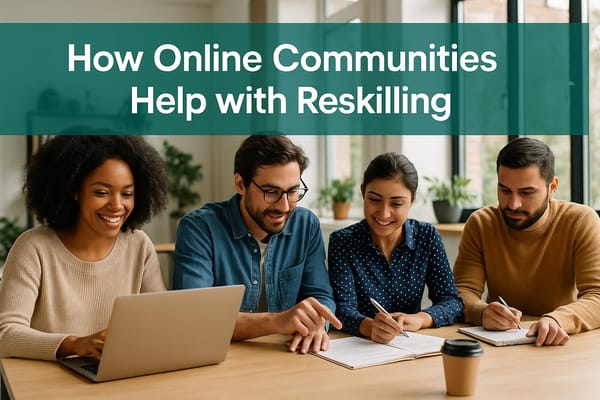10 LinkedIn Cold Outreach Tips for Jobseekers
Master LinkedIn cold outreach with essential tips to enhance your job search and connect effectively with decision-makers.

LinkedIn cold outreach can help you land your next job faster by connecting directly with decision-makers. With 44% of job placements coming from networking, it's clear that reaching out personally beats traditional applications. Here's how to do it effectively:
- Optimize Your Profile: Use a professional photo, craft a strong headline, and highlight measurable achievements.
- Find the Right People: Use LinkedIn's filters to target recruiters, hiring managers, and team leads.
- Personalize Connection Requests: Mention common interests or their work to make your request stand out.
- Send Clear Messages: Keep it concise, professional, and focused on your skills and goals.
- Engage Before Messaging: Like and comment on their posts to build familiarity.
- Offer Value: Share resources, insights, or connections to strengthen relationships.
- Follow Up Strategically: Send polite reminders, adding new value each time.
- Avoid Common Mistakes: Skip generic messages, aggressive follow-ups, or casual language.
- Use Job Search Tools: Automate applications to save time for networking.
- Stick to a Schedule: Set daily goals for connections, messages, and follow-ups.
Key Tip: Consistency and personalization are crucial. Start small, track progress, and refine your approach to build genuine connections that lead to job opportunities.
Lara Acosta's best LinkedIn cold outreach tips
1. Set Up a Professional LinkedIn Profile
Your LinkedIn profile serves as your digital first impression - make it count by presenting yourself professionally and effectively.
Craft a Strong Headline
Your headline should highlight your expertise and the value you bring. For example, instead of a generic "Software Engineer", try something like: "Full-Stack Software Engineer | Cloud Architecture | Building Scalable Solutions." It’s specific and shows your focus.
Write a Concise Summary
Use your summary to briefly outline your career journey, key achievements, skills, and what you aim to accomplish. Keep it clear and engaging.
Optimize Your Work Experience
Focus on measurable achievements and relevant expertise. Use bullet points to make your accomplishments stand out. For example:
- Implemented automated testing protocols, boosting team productivity
- Led teams to deliver major product releases ahead of schedule
- Proficient in tools like Docker, Kubernetes, and AWS
Complete Key Sections
Don’t leave important areas blank. Include:
- Education, highlighting relevant coursework
- Skills that reflect your expertise
- Certifications or licenses
- Volunteer work or personal projects
- Publications or patents, if applicable
Use a Professional Photo
Choose a recent, high-quality headshot with a neutral background. Dress professionally to make a great impression.
Finally, set your profile visibility to "Public" so potential connections can view your complete profile. A well-crafted LinkedIn profile not only reflects your professionalism but also sets the stage for meaningful connections and outreach.
2. Find Relevant People to Contact
Connecting with the right professionals on LinkedIn can make a big difference in your job search. Here's how to zero in on the people who can help you the most.
Leverage LinkedIn's Advanced Search Filters
LinkedIn's search bar and filters are powerful tools. Use them to narrow down your search by:
- Title: Look for roles like "Technical Recruiter" or "Engineering Manager."
- Company: Focus on organizations that interest you.
- Location: Limit your search to areas where you'd like to work.
- Industry: Filter by sectors that align with your career goals.
Once you’ve applied these filters, start identifying the individuals behind these results.
Focus on Decision-Makers
Prioritize connecting with hiring managers, team leads, internal recruiters, and HR professionals. These are the people most likely to influence hiring decisions.
Understand Company Structures
Dig deeper into how companies are organized:
- Look for second-degree connections who might introduce you.
- Browse employee lists to find department heads or team leaders.
- Check recent job postings to identify who’s part of the hiring process.
Pay attention to how these individuals interact with their companies. This can help you refine your approach.
Track Company Activity
Keep an eye on company pages for useful insights:
- Watch for new job postings in your field.
- See which employees are actively engaging with company content.
- Note recently promoted employees - they might be building teams.
Use Boolean Search for Precision
For more targeted results, try Boolean search techniques. For example:
(recruiter OR "talent acquisition") AND ("software engineering" OR "web development") AND "San Francisco Bay Area"
Review Profile Activity
Check out the recent posts, comments, and group memberships of potential contacts. This can give you a sense of their interests and activity level.
3. Write Custom Connection Requests
Sending a personalized connection request can greatly improve your chances of getting a positive response. With LinkedIn's 300-character limit, make sure to include:
- How you came across their profile
- Something specific about their work that caught your attention
- A clear, professional reason for wanting to connect
How to Structure Your Message
Here’s a simple structure to follow:
- Start with a personalized greeting using their name
- Provide context for why you’re reaching out
- Mention a shared interest or specific detail about their work
- State your professional purpose for connecting
- Close politely and professionally
Sample Connection Requests
For a Hiring Manager:
"Hi Sarah, I noticed you're leading the engineering team at Salesforce. Your recent post about cloud computing innovations really stood out to me. I'd love to connect and learn more about your team’s work in this space."
For a Recruiter:
"Hello Michael, I saw you recruit for tech roles at Microsoft. With 5 years of full-stack development experience, I’m currently exploring new opportunities. I’d appreciate the chance to connect and discuss potential openings."
What to Avoid
To make a good impression, steer clear of these common mistakes:
- Sending the default "I'd like to join your LinkedIn network" message
- Writing messages that get cut off due to the character limit
- Including multiple requests in your first message
- Making spelling or grammar errors
Tailor Your Approach
Adjust your message based on the recipient’s role to make it more relevant:
- Hiring Managers: Reference a recent project or achievement by their team
- Recruiters: Briefly highlight a key skill or experience
- Industry Peers: Bring up shared interests or industry trends
- Alumni: Mention your shared educational background
Show Professionalism
To leave a strong impression, follow these guidelines:
- Send messages during business hours
- Use proper titles and professional language
- Proofread your message for errors
- Be patient and allow time for a response
Your connection request is often the first impression you’ll make, so take the time to craft it thoughtfully. A well-written, personalized message not only increases your chances of a response but also sets the stage for meaningful future interactions. Once your requests are sent, you can shift your focus to writing clear and engaging follow-up messages.
4. Write Clear Outreach Messages
Once your connection request is accepted, it's time to send a concise and well-structured outreach message.
Key Elements to Include:
- A personalized greeting that references your recent connection
- A clear explanation of why you're reaching out
- A brief overview of your background and what you bring to the table
- A specific request or call to action
Best Practices for Outreach:
- Keep your message between 150-200 words
- Focus on a single goal or request
- Highlight 2-3 relevant skills or achievements
- Mention any mutual connections or shared experiences
- End with a clear and actionable request
Sample Outreach Message
"Hi James,
Thank you for connecting! I saw that you're leading software engineering at Stripe. I'm a full-stack developer with 4 years of fintech experience, currently at Square, where I helped scale our payment processing system by 200%.
Would you have 15 minutes next week to discuss potential opportunities on your team? I'm especially interested in your work on real-time payment solutions.
Best regards,
Sarah"
Timing and Context
Send your outreach message within 24–48 hours of your connection being accepted. This keeps the momentum going and builds on the rapport from your initial connection request.
Tailoring for Senior Executives
When reaching out to senior-level professionals, adjust your approach:
- Keep it shorter (100-150 words)
- Focus on high-level achievements and impact
- Show awareness of their company's challenges or goals
- Be specific about time commitments
This approach ensures your message stays relevant while respecting their time.
Professional Etiquette Tips
- Use formal business language
- Avoid using abbreviations or slang
- Double-check grammar and spelling
- Include your full name and current role
- Send your message during standard business hours
5. Like and Comment Before Messaging
Strengthen LinkedIn connections by engaging with a contact’s content before reaching out.
The 2-Week Engagement Plan
Spend 1-2 weeks interacting with your contact’s activity:
- Like and share their posts.
- Leave thoughtful comments on their content.
- Engage with updates from their company.
Crafting Thoughtful Comments
Skip the generic "Great post!" Instead, reference specific points from their content and share your perspective. For example, tie their ideas to industry trends or ask a question that encourages deeper discussion.
Focusing on Relevant Content
Pay attention to posts about industry updates, company milestones, or professional achievements. These topics often spark meaningful engagement.
Timing Your Interactions
Space out your activity to avoid overwhelming your contact:
- Engage with 2-3 posts per week.
- Comment on every 3rd or 4th post.
- Wait 24-48 hours between interactions.
- Stick to business hours (9 AM-5 PM local time).
Becoming a Familiar Name
By consistently interacting with their content, you’ll become recognizable to your contact. This increases the chances they’ll accept your connection request and respond to your messages. Use LinkedIn’s notification settings (click the "Bell" icon) to stay updated on their posts.
This approach helps create a warmer introduction, making your outreach message more likely to succeed.
6. Offer Help or Resources
Provide genuine value first - it’s a great way to increase your chances of getting a positive response.
Share Industry Insights
Offer valuable insights by sharing:
- Recent trends or updates
- Key articles or reports
- Relevant data points or event highlights
Provide Professional Resources
Send over examples like portfolio work, case studies, research summaries, or tips on tools commonly used in their field.
Make Meaningful Introductions
Connect them with useful contacts, potential clients, or qualified candidates who could benefit their work.
Support Their Goals
You can help them out by:
- Sharing their content
- Promoting their events
- Offering constructive feedback
- Suggesting a skill exchange
These actions build trust and open the door for smoother communication later.
Recommend Time-Saving Tools
Suggest tools or resources that could make their work easier. For more ideas, check out the Job Search Tools mentioned in Section 9.
Highlight Professional Development Opportunities
Point them toward growth opportunities like:
- Conferences
- Certification programs
- Workshops
- Online courses
Follow Through
If you promise something, deliver it. Respond quickly, track your commitments, and follow up to show reliability.
Keep your offers specific and tailored to their role and industry. The more relevant and practical your help is, the stronger the connection you’ll build.
7. Send Timely Follow-ups
Following up effectively requires a mix of persistence and professionalism. Here’s how to keep your outreach on point:
Give the recipient enough time before following up. If they’ve interacted with your content - like a comment or a like - you can follow up a bit sooner without seeming intrusive.
Start with a short reminder of your previous message. In later follow-ups, include new insights or information, and always end on a polite note if there’s no response.
Keep It Short and Relevant
Make your messages brief and to the point. Reference your earlier message, introduce something relevant or interesting, and include a clear next step. Keep the tone positive and professional.
Add Something New Each Time
Every follow-up should bring fresh value to the conversation. For example, you could:
- Share an article related to their industry
- Highlight mutual connections
- Reference one of their recent posts
- Offer a meaningful observation or idea
Stay Organized and Time It Right
Keep track of when you reached out, the key points you mentioned, and any responses you received. If you don’t hear back after a few attempts, it’s okay to wrap up your outreach.
When sending follow-ups, aim for business hours. That’s when most professionals are active on LinkedIn, increasing the chances of a response.
8. What Not to Do
Once you've nailed the basics of effective outreach, steer clear of these mistakes that can hurt your efforts.
Avoid Generic Messages
Sending cookie-cutter messages to multiple people can hurt your credibility. Steer clear of templates like:
- "I'm interested in opportunities at your company."
- "Looking to connect with professionals in the industry."
- "Hope to learn more about your organization."
These types of messages make it clear you haven't taken the time to research or personalize your outreach.
Don't Be Overly Aggressive
Respect boundaries when reaching out:
- Don't send repeated connection requests if the first was ignored or declined.
- Avoid asking for referrals in your very first message.
- Only mark messages as "urgent" if they truly are.
- Resist the urge to connect with everyone at the same company.
Skip the Hard Sell
Your first message shouldn't feel like you're begging for a job. Start by building a professional relationship:
- Don’t immediately ask about open positions.
- Avoid writing long paragraphs about your qualifications.
- Stay away from pushy language or anything that feels like a sales pitch.
Be Mindful of Timing
Leave at least 3-4 business days between follow-ups, and avoid sending messages on weekends or holidays.
Use Professional Language
Make sure your communication reflects professionalism:
- Skip casual abbreviations like "u" or "thx."
- Avoid overusing punctuation marks.
- Don't include emojis in your initial outreach.
- Proofread for spelling and grammar errors.
- Never use all caps or excessive formatting.
LinkedIn messages leave a lasting impression and are part of your professional record. Thoughtful, polished, and respectful communication shows your professionalism and genuine interest, shaping how others perceive you. Take the time to get it right.
9. Use Job Search Tools
LinkedIn networking is essential, but juggling multiple job applications can be overwhelming. Using job search tools alongside networking can make your job hunt more efficient.
Simplify the Application Process
Tools like scale.jobs save time by automating repetitive tasks. According to recent data, these tools can reduce job search time by 40%.
"Applying for jobs every day was super daunting. But now with scale.jobs, I can apply to hundreds of jobs daily and still focus on interview prep." - Sona Tambe
Free Tools to Boost Your Search
Pair your LinkedIn efforts with these free resources to stay organized and focused:
- Resume ATS Checker: Ensures your resume is optimized for applicant tracking systems.
- Cover Letter Generator: Creates tailored cover letters for specific job postings.
- Job Applications Tracker: Keeps track of application statuses and follow-ups.
- Interview Questions Predictor: Helps you prepare for likely interview topics.
Success in Action
Apoorv Singh, a consultant facing layoffs and visa challenges, used a combination of automated applications and targeted networking to land three job offers in just four weeks. His strategic approach even led to a 75% salary increase compared to his previous role.
Save Time and See Results
Research shows that combining networking with job search tools can significantly improve outcomes:
| Metric | Traditional Search | With Job Search Tools |
|---|---|---|
| Average Search Duration | 5 months | 1-3 months |
| Success Rate (3 months) | Not specified | 93% |
This time-saving approach allows you to dedicate more effort to LinkedIn networking and other meaningful activities.
Focus on What Matters
By automating your applications, you can spend more time on high-impact tasks like:
- Researching and connecting with key LinkedIn contacts
- Writing personalized outreach messages
- Following up with your network
- Preparing for informational interviews
- Engaging with relevant industry content
The numbers back it up: 93% of job seekers who used these tools secured full-time roles within three months. Of those, 47% succeeded through automated applications, while 44% found opportunities through personal networking.
10. Keep a Regular Schedule
Sticking to a consistent schedule is key for effective LinkedIn outreach. It’s not just about sending messages - it’s about making your networking efforts intentional and measurable. A well-planned routine can help you stay on track and increase your chances of landing interviews.
Daily Time Blocks
Dedicate specific times of your day to LinkedIn activities:
- Morning (30 minutes): Check responses and send follow-ups.
- Afternoon (45 minutes): Research potential connections and write personalized messages.
- Evening (15 minutes): Interact with industry-related posts and review any updates.
Track Your Outreach Efforts
Keep tabs on your progress to refine your approach over time. Here's a sample tracking plan:
| Time Period | Focus Area | Weekly Goals |
|---|---|---|
| Week 1-2 | Building connections | 25-30 new contacts |
| Week 3-4 | Sending follow-ups | 15-20 conversations |
| Week 5-6 | Setting up meetings | 5-8 informational interviews |
Pair this tracking system with your daily routine to maintain momentum and stay organized.
Automate Repetitive Tasks
While personal interactions are essential, automation can save you time on repetitive tasks. For example, tools like Scale.jobs can handle job applications by creating tailored resumes and cover letters, giving you more time to focus on meaningful conversations.
Set Realistic Expectations
Understanding typical response rates can help you set achievable goals:
- Connection requests: Expect around 30-40% acceptance.
- Initial messages: Anticipate a 20-25% response rate.
- Follow-ups: Gain an extra 15-20% response.
- Informational interviews: Convert about 10-15% of conversations into meetings.
Balance Quality with Quantity
Striking the right balance between quality and quantity is crucial. Here’s a simple daily breakdown:
- Morning: Send 5-7 connection requests.
- Afternoon: Write 3-4 thoughtful follow-up messages.
- Evening: Engage with 2-3 posts from your target connections.
Measure Weekly Progress
Track your results weekly and adjust your strategy if needed:
| Metric | Target Range | Adjustments if Below Target |
|---|---|---|
| New Connections | 25-30 per week | Broaden your search criteria. |
| Response Rate | 20-25% | Revise your message templates. |
| Conversations | 5-8 per week | Increase follow-up frequency. |
Conclusion
LinkedIn cold outreach can be a powerful way to speed up your job search. In fact, personal networking and individual efforts account for 44% of job placements, according to data. This makes outreach techniques an essential part of any job seeker’s toolkit.
By following these LinkedIn strategies, you can turn a scattered job search into a focused and effective plan. The secret? Staying consistent while ensuring your interactions are meaningful. Building genuine connections often opens doors to new opportunities.
On top of refining your outreach, using the right tools can make a big difference. For example, Scale.jobs simplifies the job application process, cutting the average search time from 5 months to just 1–3 months. This gives you more time to focus on networking and preparing for interviews. As one user, Shobhit Datta, shares:
"Scale.jobs streamlines high-volume job applications, saving time and increasing interview opportunities... a high-volume approach helped me get few interview calls which I wasn't getting earlier." - Shobhit Datta




